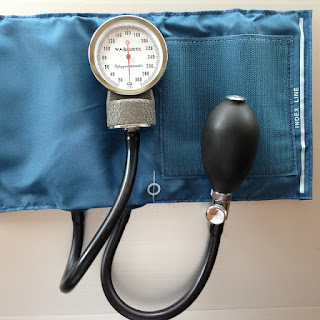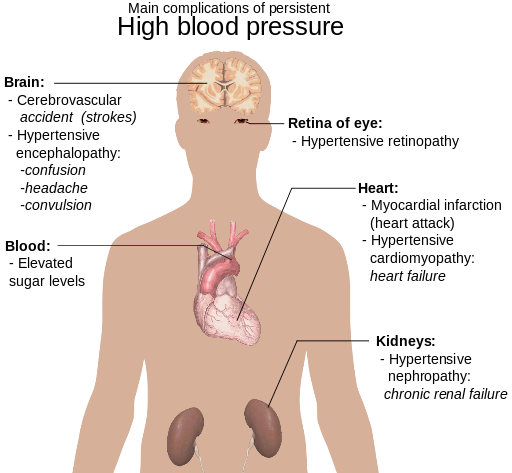What is Blood Pressure?
Blood pressure is the force that blood exerts on the walls of blood vessels as it circulates throughout the body. High blood pressure occurs when the force of blood against the arterial walls is consistently too high, which can cause damage to the blood vessels over time. This can lead to a number of serious health problems such as heart disease, stroke, and kidney failure.
Why is high blood pressure called the silent killer? It is often called the "silent killer" because it usually has no noticeable symptoms until it is too late and organ damage starts to become apparent.
How is Blood Pressure measured?
Blood pressure is typically measured using a sphygmomanometer, which is a device that consists of an inflatable cuff, a pressure gauge, and a stethoscope. The measurement is expressed as two numbers, systolic pressure and diastolic pressure, which are recorded in millimeters of mercury (mm Hg). What is mmHg? Well, the term comes from the historical use of mercury in barometers and manometers, which were instruments used to measure atmospheric pressure.
Systolic Vs Diastolic
Systolic and diastolic blood pressures are two key components of a blood pressure reading. They represent different aspects of the pressure within your arteries during the cardiac cycle.
- Systolic blood pressure: This is the higher (and top) of the two numbers in a blood pressure reading. It measures the pressure in your arteries when your heart is contracting (beating) and pumping blood into the circulation. Systolic pressure is an indicator of how hard your heart is working to pump blood and deliver oxygen and nutrients to the rest of the body.
- Diastolic blood pressure: This is the lower (and bottom) of the two numbers in a blood pressure reading. It measures the pressure in your arteries when your heart is at rest, between beats. Diastolic pressure is an indicator of the baseline pressure in your arteries when your heart is not actively pumping blood.
For example, a blood pressure reading of 120/80 mm Hg indicates a systolic pressure of 120 mm Hg and a diastolic pressure of 80 mm Hg.
Blood Pressure Measuring Procedure
The person being tested should sit down and relax for a few minutes before the test.
The cuff is wrapped around the upper arm and inflated to a pressure that is higher than the systolic pressure.
The pressure in the cuff is gradually released while the healthcare provider listens to the sounds of blood flow in the artery using the stethoscope.
The point at which the first sound is heard indicates the systolic pressure, and the point at which the sound disappears indicates the diastolic pressure.
What is Considered Healthy and Normal Blood Pressure?
A blood pressure reading of 120/80 mmHg or lower is considered normal blood pressure.
What time of day is blood pressure the highest?
Blood pressure can vary throughout the day due to various factors, including physical activity, stress, and sleep patterns.
Typically, blood pressure tends to be higher in the morning, usually within a few hours of waking up, and then gradually decreases throughout the day. This pattern is due to the circadian rhythm.
The circadian rhythm is a natural, internal process that regulates the sleep-wake cycle and repeats approximately every 24 hours. It is a biological clock that helps organisms, including humans, adapt to the daily cycle of light and darkness. The term "circadian" comes from the Latin words "circa," meaning "around," and "dies," meaning "day."
Circadian rhythms are driven by biological processes called "clock genes" and are influenced by environmental cues, especially light. These rhythms are present in various aspects of an organism's physiology, including sleep patterns, hormone release, body temperature regulation, and metabolism.
Can blood pressure get too low?
Low blood pressure, also known as hypotension, can be defined as a blood pressure reading below 90/60 mmHg. However, what is considered "too low" for blood pressure can vary from person to person, as some individuals may experience symptoms of hypotension even when their blood pressure is within the normal range.
In general, a blood pressure reading that is significantly lower than a person's usual blood pressure or that causes symptoms such as dizziness, lightheadedness, fainting, or blurred vision may be considered too low. Severe hypotension (systolic blood pressure below 70 mmHg) can be a medical emergency, as it can lead to shock and organ failure.
Some common causes of hypotension include dehydration, blood loss, certain medications (such as diuretics or blood pressure medications), heart problems, endocrine disorders, and severe infections.
What is prehypertension?
Prehypertension (or Borderline Hypertensive) is a term used to describe blood pressure levels that are higher than normal, but not yet high enough to be considered hypertension (high blood pressure). The condition is diagnosed when a person's systolic blood pressure (the top number) is between 120 and 139 mmHg or diastolic blood pressure (the bottom number) is between 80 and 89 mmHg.
Prehypertension may not cause any noticeable symptoms, but it can still be a cause for concern, as it puts individuals at higher risk for developing hypertension and other cardiovascular diseases. Prehypertension is often treated with lifestyle modifications such as eating a healthy diet, exercising regularly, reducing salt intake, and maintaining a healthy weight. In some cases, medication may be prescribed to manage prehypertension.
 |
| Blood Pressure Chart |
A reading of 120/80 mmHg (millimeters of mercury) or lower is considered normal blood pressure. However, a reading of 130/80 mmHg or higher is considered high blood pressure. If your blood pressure is consistently higher than 130/80 mmHg, you should consult with your doctor to discuss treatment options.
What is a Hypertensive Crisis?
A hypertensive crisis is a severe increase in blood pressure that requires immediate medical attention to prevent damage to vital organs such as the brain, heart, or kidneys. There are two types of hypertensive crises: hypertensive urgency and hypertensive emergency.
Hypertensive urgency occurs when the blood pressure is severely elevated (systolic blood pressure > 180 mmHg or diastolic blood pressure > 120 mmHg) but there is no evidence of acute organ damage. Symptoms of hypertensive urgency may include severe headache, shortness of breath, nosebleeds, and anxiety. Treatment for hypertensive urgency involves taking medication to lower blood pressure gradually over a period of hours to days.
Hypertensive emergency, on the other hand, is a more severe condition that occurs when the blood pressure is extremely high and there is evidence of acute organ damage. Examples of acute organ damage include acute heart failure, acute kidney injury, acute pulmonary edema, or neurologic symptoms such as confusion or seizures. Hypertensive emergency requires immediate medical attention, typically in an emergency department or intensive care unit. Treatment may involve medications to rapidly lower blood pressure, such as intravenous nitroglycerin or sodium nitroprusside. Other interventions may be necessary to address the underlying cause of the hypertensive crisis, such as managing heart failure or kidney injury.


